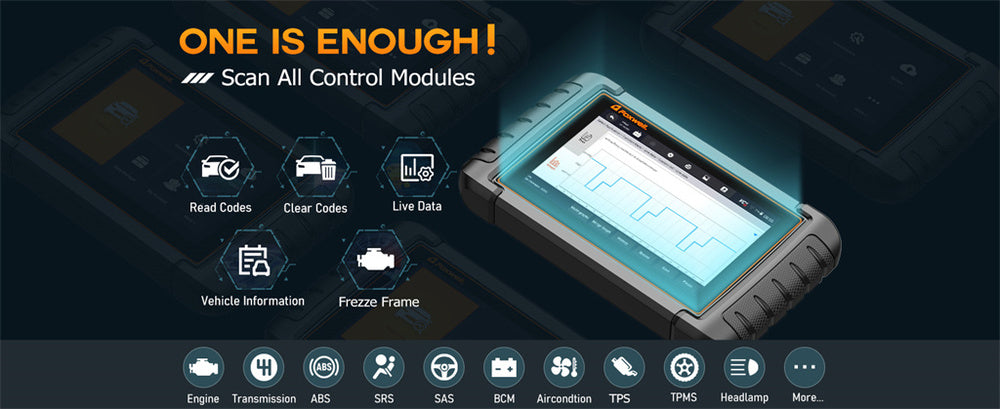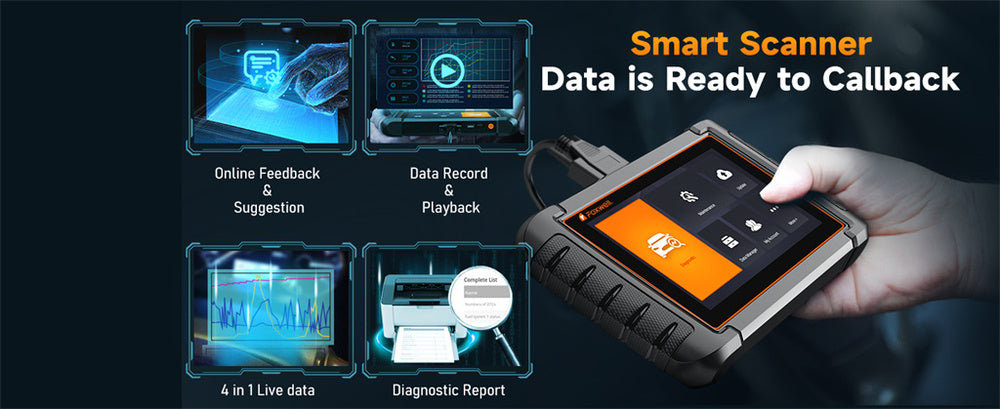When faced with a vehicle that won't start, many turn to an onboard diagnostics OBD2 scanner to pinpoint its cause. But will an OBD2 scanner work if it refuses to start? Understanding its function, capabilities, and how it may aid in diagnosing non-starting vehicles is paramount.
We explore its practical use case by addressing common causes behind non-starting cars while suggesting alternative troubleshooting techniques as we look into its practicality before providing further details that may help determine when OBD2 scanner assistance might come into play or if professional assistance may be required.
Can an OBD2 Scanner Work When the Car Won't Start?

The short answer: yes, an OBD2 scanner may still work even when your car won't start, with certain limitations. As long as enough charge is left in its battery to power its electronics, an OBD2 scanner can still connect and retrieve trouble codes and access data; its diagnostic capabilities depend on what caused its non-start issue.
OBD2 scanners do not always function properly if a car's battery dies; otherwise, their electronic control module (ECM) and other systems will no longer receive power.
Furthermore, when dealing with mechanical problems like failed fuel pumps or starter motors, an OBD2 scanner may not offer definitive answers. Rather than mechanical issues, it focuses more on reading electronic data related to engine performance, emissions, and electrical systems.
Common Reasons Why a Car Won't Start
Familiarizing yourself with the common reasons a car won't start can help you determine whether an OBD2 scanner or other means are needed for diagnosis. Here are the main categories:
Battery Issues:
- Dead or Weak Batteries:A dead battery prevents power from reaching any of your vehicle's electronics, including the OBD2 system. In weak batteries, dimmed lights or clicking noises when turning the key may indicate their condition.
- Corroded or loose battery terminals: Corrosion of battery terminals or loose connections can reduce power delivery, cause start-up issues, and result in poor starting performance.
Failure of Starter Motor:
Your starter motor is responsible for starting up your engine when you turn over the key; should it fail, your engine won't begin cranking despite other working electrical components. Unfortunately, this issue won't trigger an OBD2 code as the mechanical starter motor is not subject to this testing procedure.
Fuel Delivery Issues:
- Filter Issues or Blockages:A fuel pump failure prevents an engine from starting, which could mean either that its delivery system has failed or that an obstruction exists that needs to be cleared before starting the engine.
- Empty Fuel Tank or Bad Fuel: Surprisingly common, one reason a car won't start could simply be that it is out of gas or has poor-quality fuel.
Ignition System Issues:
A malfunctioning ignition coil, distributor, or spark plug can prevent an engine from starting. Ignition system malfunctions can sometimes produce trouble codes related to crankshaft position sensor issues.
Sensor Failures:
Engine timing relies heavily on critical sensors like camshaft or crankshaft position sensors. If these fail, your ECM may prevent your engine from starting—an OBD2 scanner can often identify this issue.
Using an OBD2 Scanner to Diagnose a Non-Starting Car
If your car won't start, an OBD2 scanner could help identify its root cause. One such scanner is the Foxwell NT726; its advanced features, like system-wide diagnostics, live data streaming, and code reading capability, provide excellent assistance in these instances.
Before connecting an OBD2 scanner, ensure the battery has a sufficient charge. OBD2 scanners like Foxwell NT726 require power from your car's battery; if its charge has died out, you may need to jump-start it or replace it before connecting.
Plug the NT726 scanner into the OBD2 port located under the dashboard on the driver's side. Turn your ignition key to "ON" without starting your engine, and allow the vehicle's electronics to power on before connecting the scanner to any of its systems.
Read Trouble Codes: Use your Foxwell NT726's "Read Codes" menu option for straightforward trouble code interpretation and explanations.
This scanner provides detailed trouble codes and explanations that help identify potential issues with components like ignition, fuel, and emissions systems; additionally, if there's an issue with an essential sensor like the crankshaft position sensor, it often detects and displays a corresponding code.
- Analyze Live Data: The NT726 also offers real-time viewing, which can help diagnose non-starting vehicles. You can monitor real-time parameters like fuel pressure, throttle position, and ignition timing—for instance, abnormal fuel pressure readings could indicate issues with your fuel pump.
By analyzing real-time values, you can more quickly pinpoint which system has failed to function as intended.
- Clear Codes and Recheck: After diagnosing and fixing an issue, use the Foxwell NT726 to clear any stored trouble codes. This step is crucial if the problem has been successfully fixed, as it will reset the check engine light while allowing you to monitor any recurrences of issues addressed during repairs.
If the car still doesn't start after repairs, rescan again to detect additional codes that might arise from this step.

Alternative Methods to Diagnose Starting Problems Without an OBD2 Scanner
If an OBD2 scanner cannot identify your starting problem or you do not have one on hand, alternative methods exist for diagnosing starting problems:
- Check Battery Voltage:Use a multimeter to check the battery voltage. A healthy battery should register around 12.6 volts when the engine is off; if the voltage falls below this mark, attempt charging or jump-starting your vehicle until its voltage returns. Inspect Battery Connections:
Examine the battery terminals visually for signs of corrosion and ensure all connections are tight. Remove any deposits with a wire brush before reconnecting securely.
- Listen for the Fuel Pump: When turning on your engine, listen for a faint whirring sound coming from the fuel pump. If this noise doesn't exist, the pump may be broken and require replacing immediately.
Use a multimeter or test light to verify whether the starter motor receives power. If energy appears to be being supplied but the starter does not turn over, this could indicate that it needs replacement, and further investigation may be required.
- Check for Spark: If you suspect an ignition problem, using a spark tester will help identify whether or not spark plugs are firing correctly. An absence of a spark may signal issues within the ignition system, with coils or spark plugs being an indicator.
Preventive Maintenance Tips to Avoid Starting Issues
Routine car maintenance can help save you from dealing with starting issues in the future, providing some helpful preventive tips:
- Keep Your Battery Charged and Terminals Clean: For optimal battery performance, inspect battery terminals regularly for corrosion and clean them when necessary. Consider upgrading every few years to avoid unexpected problems with your current setup.
- Check Fuel Quality and Filters: Investing in high-grade fuel and regularly replacing its filter helps preserve system integrity and prevent clogs.
- Examine Your Ignition System: For optimal starting performance, regularly inspect and replace worn spark plugs, ignition coils, and distributor caps in your ignition system to avoid potential problems caused by ignition-related starting issues.
- Regular Sensor Checks: Camshaft and crankshaft position sensors are crucial at the start. Inspect them regularly if you experience symptoms such as rough idling or misfires.
Preventive maintenance not only reduces the risk of starting issues but also extends the lifespan of your vehicle.
Conclusion
OBD2 scanners can be invaluable when diagnosing a car that won't start, provided the problem lies within its electronic systems.
For example, its advanced features include ignition and sensor codes to identify ignition problems or malfunctions. However, OBD2 scanners cannot diagnose battery, starter motor, or fuel issues alone and may have limited capabilities.
If an OBD2 scanner doesn't answer, alternative diagnostic techniques, like checking battery voltage or testing the fuel pump, can provide relief. When this fails, professional assistance from experienced technicians with access to unique tools could provide more precise insight.
FAQs
Can I use a code reader if my car won't start?
Yes, as long as the battery has enough charge to power the car's electronics, you can connect a code reader to retrieve trouble codes.
Do you have to start the car to use the OBD2 scanner?
No, you don’t need to start the car. Turning the ignition to the “ON” position without cranking the engine is usually enough to access the vehicle’s data with an OBD2 scanner.
Can an OBD scanner detect starter problems?
Not directly. An OBD scanner mainly reads electronic trouble codes and may not detect mechanical issues like a faulty starter motor. However, it can sometimes identify related issues that may affect the starting system.




Leave a comment
This site is protected by hCaptcha and the hCaptcha Privacy Policy and Terms of Service apply.